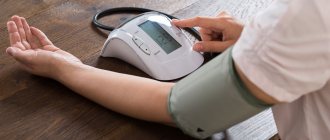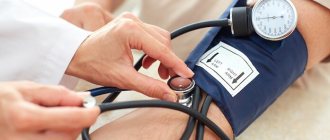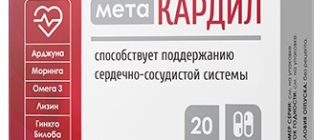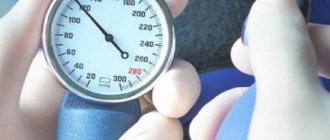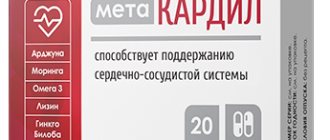Regular blood pressure measurements help detect hypertension at an early stage. Pressure 160 to 80 mmHg. Art. may be a sign of a serious pathology or talk about a reaction to external factors: stress, physical overload, severe anxiety. To determine the cause of high blood pressure, you should consult a doctor. A comprehensive examination, medical history, and tests will help determine the pathogenesis and select the appropriate treatment. You cannot relieve high blood pressure with medications on your own.
160/80 – normal or deviation, is it worth knocking down?
Hypertension is a dangerous disease that manifests itself in elevated blood pressure. Blood pressure rises regularly and it can be quite difficult to bring it down. A blood pressure of 160 over 80 causes bewilderment for many, since only the systolic value is increased, while the diastolic pressure remains within the normal range. Should we consider this condition a violation and sound the alarm? It’s worth it, because we can talk about isolated hypertension, which is no less dangerous than ordinary hypertension.
But there is no need to sound the alarm ahead of time. If blood pressure increases after exercise to 160 over 80, and then returns to normal within a couple of hours, there is no pathology. This is a normal reaction of the body to severe physical fatigue. Also, a pressure jump of 160 to 80 would be the norm for hypertensive patients.
If arterial values increase in a calm state and do not fall on their own for a long time, you need to consult a doctor who will check the condition of the cardiovascular system, conduct a comprehensive examination and make a diagnosis.
High blood pressure is a symptom that should not be ignored
Meaning of indicators
Many people know what hypertension means for the human body. In the case of a blood pressure of 160 over 80, people do not know what to do or whether to take medications, because only the first number is elevated. In this situation, we are talking about a special type of hypertension, which is usually called isolated or systolic hypertension.
Hypertensive patients do not need to lower their blood pressure to 160/85. This is a normal indicator for them. After physical activity, blood pressure also increases in healthy people. That is why, if you see these numbers on the tonometer, do not rush to swallow the pills. Calm down and wait 20 minutes - your condition should normalize.
If a jump in blood pressure is observed in a calm state, it is necessary to undergo a comprehensive examination of the heart and blood vessels. Be sure to also check the thyroid gland and kidneys.
Why does upper pressure increase?
In old age, elevated blood counts up to 160 units are not surprising. With age, rates increase in men and women. Cholesterol plaques form on the vascular walls, the elasticity of the vessels decreases, and during cardiac output they stop stretching, as a result of which the pressure increases. An increase in systolic readings to 160 units indicates a loss of vascular elasticity.
Blood pressure of 160 to 80 in men can be caused by the following factors:
- anemia;
- heart valve insufficiency - a condition in which blood from the aorta flows back into the heart; with repeated contractions of the heart muscle, a double volume of blood enters the vessels, which leads to an increase in arterial value to 160 points;
- excessive production of thyroid hormones;
- atrioventricular block - a violation of the conduction of electrical impulses from the atria to the ventricles.
Blood pressure of 160 to 80 in women is caused by the same factors. If you pay attention in time to the causes of pressure 160 over 80 and remove them from your life, you can avoid the development of hypertension.
What is the danger of pressure 160/100
Systolic pressure reaching 160 is very dangerous for health. First of all, the blood vessels suffer. The elasticity of the walls decreases, as a result of which they can no longer fully contract and relax. With consistently high levels, the risk of developing the following deviations increases:
- renal dysfunction;
- decreased visual acuity;
- possible changes in lung tissue;
- high risk of heart attack;
- the likelihood of a stroke.
If hypertension is left untreated, there is a high risk of stroke
The listed conditions are already complications. Hypertension itself at such indicators is characterized by the occurrence of frequent crises. They occur differently in all patients and in some cases can cause hospitalization. In order to prevent an attack of hypertension, it is enough to pay close attention to your health and consult a doctor at the first symptoms of high blood pressure.
Associated symptoms
A person's blood pressure is 160 over 80 and may not manifest itself physically in any way. The patient's condition depends on the cause of the increase in indicators. Against the background of increased blood pressure, the following symptoms may appear:
- hyperemia;
- increased heart rate;
- headaches;
- increased nervous excitability;
- chills;
- trembling of limbs;
- gagging;
- dizziness;
- black spots before the eyes.
Often the cause of pressure 160 to 80 is a lack of important minerals - potassium and magnesium. The patient will not have any accompanying symptoms, and he will be able to find out about the cause of the pathology only after a blood test.
Headaches may be the first symptoms of increased upper blood pressure
Symptoms
A blood pressure reading of 160 over 80 does not have any serious symptoms. The patient’s well-being with this indicator depends on the cause that provoked it. For example, if an increase in blood pressure was caused by heavy physical activity, then a person will not feel anything other than fatigue. If this indicator appears against the background of concomitant diseases, a person may feel:
facial redness;- cardiopalmus;
- headache;
- irritability;
- chills;
- hand tremors
In rare cases, nausea, vomiting, dizziness and spots before the eyes are observed.
A deficiency of potassium and magnesium in the blood can cause a jump in systolic blood pressure. In this case, a person does not feel any symptoms and learns about the lack of important elements only after examination by a doctor.
Pulse readings
If the systolic reading is elevated, it is necessary to monitor the pulse. The pulse is responsible for the rhythm of the heart and the contractility of the heart muscle.
Heart rate directly indicates the state of the cardiovascular system. With a blood pressure of 160/80 in adults, the norm would be a pulse of 60-70 beats per minute. If the pulse exceeds the specified values, you should consult a doctor.
The doctor will refer the patient for electrocardiography, ultrasound examination of the heart and thyroid gland.
To normalize the readings at 160 to 80 points and restore the heart rate, the doctor will prescribe beta-blockers and sedatives.
With a pulse of 80 beats per minute, the heart works with double the load, which significantly affects its condition and the quality of blood supply.
Features of isolated hypertension
In most cases, pressure increases in both indicators at once. Therefore, at a time when there is a systolic pressure of 160, and the diastolic pressure is within the normal range, patients are lost in the issue of first aid. Conventional antihypertensive drugs can lower both levels, which has its own risks.
In the elderly, a condition such as isolated hypertension is often observed, when only the upper pressure increases
If only the upper indicator increases, we are talking about isolated hypertension. This deviation is especially common in older people. The reason in this case is a decrease in the elasticity of blood vessels. Subsequently, this can lead to pathologies of the kidneys and heart.
The condition is no less dangerous for young people. If abnormalities are detected early, there is a possibility of rapid progression of the pathology to the final stage. This can lead to frequent complications and even death.
Reasons for rejection
The following reasons can provoke deviations in the upper indicators:
- malnutrition - excess salt provokes fluid accumulation, which causes an increase in blood pressure;
People who are overweight are more likely to develop hypertension
- increase in body weight - due to increased load, the vessels simply cannot cope with the volume of blood;
- lack of potassium – if the balance of microelements is disturbed, a change in water-salt metabolism is noted;
- lack of movement - negatively affects vascular tone;
- bad habits – increase the risk of blood clots.
Isolated hypertension can be observed against the background of serious renal dysfunction, diabetes mellitus and liver failure.
Diabetes can also lead to the development of isolated hypertension
Signs of pressure 160/90
It is characteristic that with such tonometer readings, the disease may not manifest itself in any way. The first sign, and sometimes the only one, is sleep disturbances. This alone should alert the patient and cause him to see a doctor. Light sleep may also indicate isolated hypertension.
Further, as the pathology progresses, the following signs appear:
- noise in the head;
- skin hyperemia;
- irritability;
- dizziness;
- sweating;
- pronounced palpitations;
As hypertension progresses, numbness in the fingers may occur.
- numbness of fingers;
- swelling (mainly in the facial area);
- increased fatigue.
The listed symptoms require a thorough examination of the patient and determination of the cause of the deviations. Only after this can treatment be prescribed.
What to do if your blood pressure is 160/80
If the condition has worsened and the blood pressure monitor shows elevated blood levels, you need to calm down and rest a little. An increase in systolic readings can be triggered by various external factors, including physical activity or stress.
After stress or increased physical activity, it is necessary to massage the collar area or upper back. These areas should be gently stretched so that the pressure returns to normal values.
If the tonometer shows an upper pressure of 160 and a lower pressure of 80, you need to calm down and take measurements again; if the readings remain within 160 units, you should consult a doctor.
Massage of the collar area helps to calm down and relax
Help at home
To lower blood pressure from 160 to 120 points at home without medical intervention, you can take a warm bath with a water temperature no higher than 36 degrees. You do not need to immerse yourself completely in the bath; it is intended for your hands. Just 10 minutes in warm water will normalize blood pressure.
If the readings increase again to 160 units, you should take a Captopril or Valocordin tablet.
Captopril lowers blood pressure through its effect on brain receptors. Valocordin is a sedative: it reduces vascular spasms, normalizes heart rate, and calms.
If elevated blood counts are accompanied by severe pain in the head, you need to take a painkiller. If the pain does not go away and the condition worsens, you should call an ambulance.
Drugs for further therapy
Medicines to normalize blood pressure values at an upper value of 160 mmHg. Art. prescribed by the attending physician after examination, collection of tests, determination of pathogenesis and collection of anamnesis. Tablets should not be taken at a pressure of 160 to 80 without a doctor’s prescription, since the selection of the drug is carried out individually according to indications. Self-administration of antihypertensive drugs can cause a backlash and lead to a hypertensive crisis or other disorders.
Any blood pressure medication must be prescribed by a doctor
You can reduce blood pressure to 160/80 with the following medications:
- Lisinopril;
- Lorista;
- Noliprel;
- Physiotens;
- Enalapril.
In severe cases of hypertension and in old age, the doctor will prescribe beta-blockers Anaprilin, Blockarden, Lokren or calcium antagonists Verapamil, Lacidipine, Flunarizine. Among the sedatives, mild medications Persen and Afobazol are distinguished.
Nutrition correction
If your blood pressure is 160/80, your diet should be adjusted. You need to stop eating flour, sugar, fatty and spicy foods. The diet should be healthy and balanced, without cholesterol and other harmful substances. You should limit your consumption of canned foods, fast food, carbohydrates, smoked foods, and spices.
The patient's diet should include more stewed, fresh, boiled vegetables and fruits.
Whole grain porridge will be beneficial. They contain many useful minerals that have a positive effect on the functioning of the heart and blood vessels.
How to treat blood pressure 160/100
In the presence of second degree hypertension, therapy should begin immediately. Any delay increases the risk of complications. If your condition allows, you should visit a doctor at the clinic. If, if the pressure is 160/100 (110), the condition is serious, you need to call an ambulance and remain in bed until it arrives.
Call an ambulance as soon as possible
After the examination, the doctor determines what exactly caused the deviations. After this, effective treatment is prescribed. As a rule, these are antihypertensive drugs, selected individually. It is also important to follow a diet and adjust your daily routine during therapy.
You cannot refuse treatment. Modern drugs have a minimum of side effects, which allows them to be taken for a long time.
Features of treatment for men
In case of stage 2 hypertension, blood pressure should be brought down to normal levels as quickly as possible. In most cases, Nifedipine is used. Due to the active component, it is possible to normalize the nutrition of heart tissue and at the same time reduce blood pressure. If the effect is insufficient within half an hour, taking a second tablet is allowed.
To relieve an attack, you can take a Nifedipine tablet
Beta blockers and diuretics are also appropriate. It is extremely important to calm down. In this regard, taking sedatives is allowed. Corvalol works great for some men.
Normalization of blood pressure in women
In women, a crisis occurs especially often, therefore, at the first symptoms of an increase in blood pressure to 160, medications should be taken. Nifedipine, Captopril and Atenolol would be appropriate.
Before the doctor arrives, you should ventilate the room, take sedatives, and you can perform several breathing exercises.
You can also take Captopril if you have high blood pressure.
How to help pregnant women
Particular attention should be paid to the condition during pregnancy. For them, increasing blood pressure to 160/100 is extremely dangerous. With such numbers, blood flow suffers, not only in the mother’s organs, but also in the placenta, which can lead to oxygen deficiency in the fetus.
When carrying a baby, to lower blood pressure, it is allowed to use drugs such as Dopegit, Atenolol, Nifedipine, Labetolol, and so on. But before taking them, you should try to reduce the pressure with improvised means. This is as follows:
- ventilation of the room;
- distracting procedures;
- sedatives (without alcohol).
Pregnant women can be prescribed a drug such as Dopegit
If the pregnant woman's blood pressure is persistently high, hospitalization may be required.
After providing first aid, it is necessary to continue treatment to prevent another attack. In addition to the medications prescribed by a specialist, it is important to change your diet, minimizing the consumption of salts, fats and smoked foods. Stress should be avoided whenever possible. You should definitely train your blood vessels. To do this, just take daily walks. This will not only lower blood pressure, but improve sleep, which often suffers in hypertensive patients.
Prevention of hypertension
To reduce the risk of developing systolic hypertension, it is recommended to review your lifestyle. An important role is played by giving up bad habits - alcohol and smoking.
Giving up bad habits is the first step towards fighting hypertension
Heart tone is directly related to general well-being. Obesity has a bad effect on the functioning of the cardiovascular system, so first of all it is recommended to lose weight. You definitely need to do gymnastics and do simple physical exercises. Regular walks in the fresh air have a positive effect on the functioning of the heart. It is recommended to eliminate stress and worries from life as much as possible.
The diagnosis of “systolic hypertension” is not a death sentence. The disease can be easily cured if you monitor your quality of life. It is enough to change your attitude towards yourself and your health so that the systolic indicators return to normal.
How to avoid it in the future?
What should I do to prevent the upper pressure from increasing? You can avoid deviations if you follow these rules:
- Completely stop drinking alcohol or drink alcohol in limited quantities;
- You need to sleep at least 7 hours a day;
- To refuse from bad habits.
In addition, you need to limit your salt intake. When cooking, it is best to use various herbs, aromatic spices, and season dishes with good soy sauce. Nutrition should be balanced. To prevent an increase in systolic pressure, you need to eat a lot of fresh fruits, greens, and foods that contain a lot of potassium (dried apricots, onions).
A slight fluctuation in pressure should not frighten the patient; if this phenomenon occurs frequently, you should contact a medical facility.
